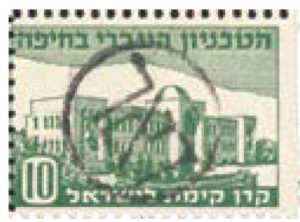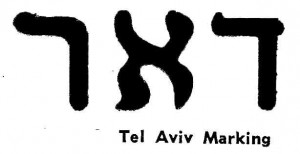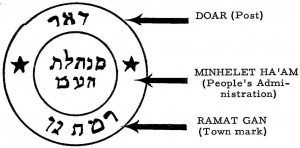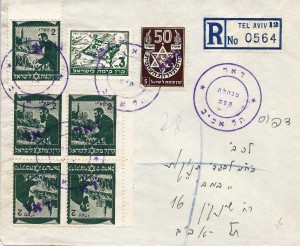INTERIM PERIOD II
PHILATELIC
March 22, 1948 – August 8, 1948
OFFICIAL
May, 1948 – May 15, 1948
T
MINHELET HA’AM
“The British Mandate officials were planning only the liquidation and not any continuation of such services. In the case of the postal services, this came about in three phases.
- On March 15, 1948, secondary and outlying post offices were informed by telephone that their functions had been terminated.
- On April 15, 1948, a majority of the remaining offices were closed in a similar manner, . . .
- . . . leaving only the main offices in the major cities operating under the British postal rules, and they were closed (nominally) on May 5, 1948.”
Forsher, p. 6
“The Minhelet Ha’am Council agreed to adopt an emergency measure which was to be uniformly observed until the appearance of the first stamps of lsrael.
- It authorized the use of a wide variety of Jewish National Fund (KEREM KA YEMET L’YISRAEL) labels, to be validated for postal use by over printing with the Hebrew word “DOAR” (post) and
- to be cancelled with a new all-Hebrew canceler, or Minhelet Ha’am postmark.”
Forsher, p. 7.
(See bottom for more Background information)
Stamps
“All of these stamps are Keren Kayemeth L’Yisrael (Jewish National Fund) labels which were
validated for postal use by one of the DOAR markings [Editor’s highlight] . . . . “
“Except for these early occurrences, the provisional stamps of the Interim Period of Israel follow a definite pattern and are restricted to the issues listed on the following pages in this section. ”
Forsher, p. 21.
Overprints
(Validation Markings, making
labels into Postage Stamps)
“These markings are of considerable interest to the Israel philatelist as they not only represent a criteria of differentiation, hence – different validation marks on the same K.K.L. label produced different postage stamps, but also a criteria for the recognition of forgeries.
. . . the genuine postal validation marks which were placed on the K.K.L. labels, thus turning them into postage stamps . . . .
. . . only three distinct types of postal validation markings are known, and these are listed in respect to their place of origin as the markings of Tel Aviv, Haifa and Kiryat Motzkin.”
Forsher, p. 12.
Covers
Postmarks
“The cancellation devices provided by the National Administration Council to 80 post offices which remained in operation during this short period were crude rubber stamps, with inscription in the Hebrew script only. No provision for dating was provided. Post offices either had to use a simple rubber date stamp or they did not date the letters or other items to be processed. In a few instances, the retired British Mandate canceller was used as a date stamp.
Two major types of these postmarks are known:”
Forsher, p 15.
“Almost all of the Interim Period postmarks are known on cover in both violet and black color, as ink pads of both colors were readily available in all the operating post offices. In Zefat, only red or black postmarks (no violet marks) were struck.”
Forsher, p. 17.
Type “A”
Example of a postmark, Type “A”. Outer circle measures 34 to 36 mm diameter, inner circle 21 mm diameter. Two stars. Neat Hebrew lettering.
Type “B”
Example of a postmark, Type “B”. Deformed circles, crude lettering. Arrow points in the place of the stars.
Registered Minhelet Ha’am Cover
BACKGROUND
GENERAL
“. . .the Jewish community of Palestine, known at the time and henceforth called the YISHUV. sent
“. . . an invitation to thirteen leaders of the Yishuv for an April 18, 1948, meeting and to form a body for the purpose of administering the interests of the Jewish State, the creation of which still lay in the future.
“. . . proposed to call this body the MINHELET HA’ AM (meaning: People’s Administration, or National Administration) and this name was adopted and it can be found on every postal cancellation on covers originating during the Interim Period. The National Administration acted in co-operation with the National Council of Palestine Jews, also known as the VA’ AD LEUMI.
. . . Thus it became the duty of the National Administration to take action when, without any warning, the British Mandate postal services were discontinued.”
Forsher, pp. 2-3.
STAMPS
“It has never been ascertained how the issues of these K.K.L labels were selected. It appears that they were selected at random from available supplies, possibly avoiding some issues with political connotations. This alone would account for the amazing number of varieties found in use during this brief interval.
The Interim issues with Doar overprints were first placed on sale on May 2, 1948 and they nominally remained on sale until May 16, 1948, the day of the issue of the DOAR IVRI series, the first stamps of the State of Israel. Their legitimate use was to have ended on May 23, but due to the war-like conditions of the period which resulted in restricting the flow of supplies, their occasional use on much later dates up to the beginning of the first truce can be found. The characteristics of the Minhelet Ha’am postmarks and of the Doar overprintings are explained in great detail in one of the following sections of this handbook.
When on May 16, 1948, the first stamps of Israel became available, it was not possible to supply all eighty localities where post offices had remained in operation with either the new stamps, or the new State of Israel canceller. Hence, many of these offices were advised to continue to use the Interim issues and reactive the use of the retired British Mandate cancellers until their new State of Israel canceller would become available. However, some of the small stations had discarded the hateful device of British officialdom, and they continued using the Minhelet Ha’am postmark and a simple rubber date stamps, so that either or both appear on some pieces of mail originating during the early days of Israel.
Forsher, p. 7
POSTMARKS
Good forgeries of some of the Minhelet Ha’am postmarks are also known to exist. Those of Affulah, Nahalal, Tiberias and Rishon leZion are most prominent. They were prepared to produce “rare covers,” using forged provisional local stamps (British Mandate stamps with Hebrew overprinting) so they may be accepted as genuine by unsuspecting collectors.
Forsher, p.17.
REFERENCES
- THE INTERIM PERIOD POSTAGE STAMPS OF ISRAEL, MARCH TO JULY 1948. Second Printing, September 2014. Bruno J. Forsher Photography by L. I. Edos. A HANDBOOK OF THE SOCIETY OF ISRAEL PHILATELISTS. Published by the Educational Fund of the Society of Israel Philatelists. (NOTE: this publication has a Bibliography of “66”entries.)
- AN INTRODUCTION TO THE INTERIM PERIOD OF 1948. The Israel Philatelist, Volume 39, No. 11-12. Suse Judith. pp 5555 – 5559.
- A Brief Overview Of Holy Land Philately. The Israel Philatelist. Spring, 2017. Sid Morginstin. pp. 52 -53.
- BALE Catalogues. Israel Postage Stamps. Specialized catalogue 1948 – 2016. 24th Edition. Compiled and Edited by Joseph D. Stier. 2016,
Tel Aviv.






